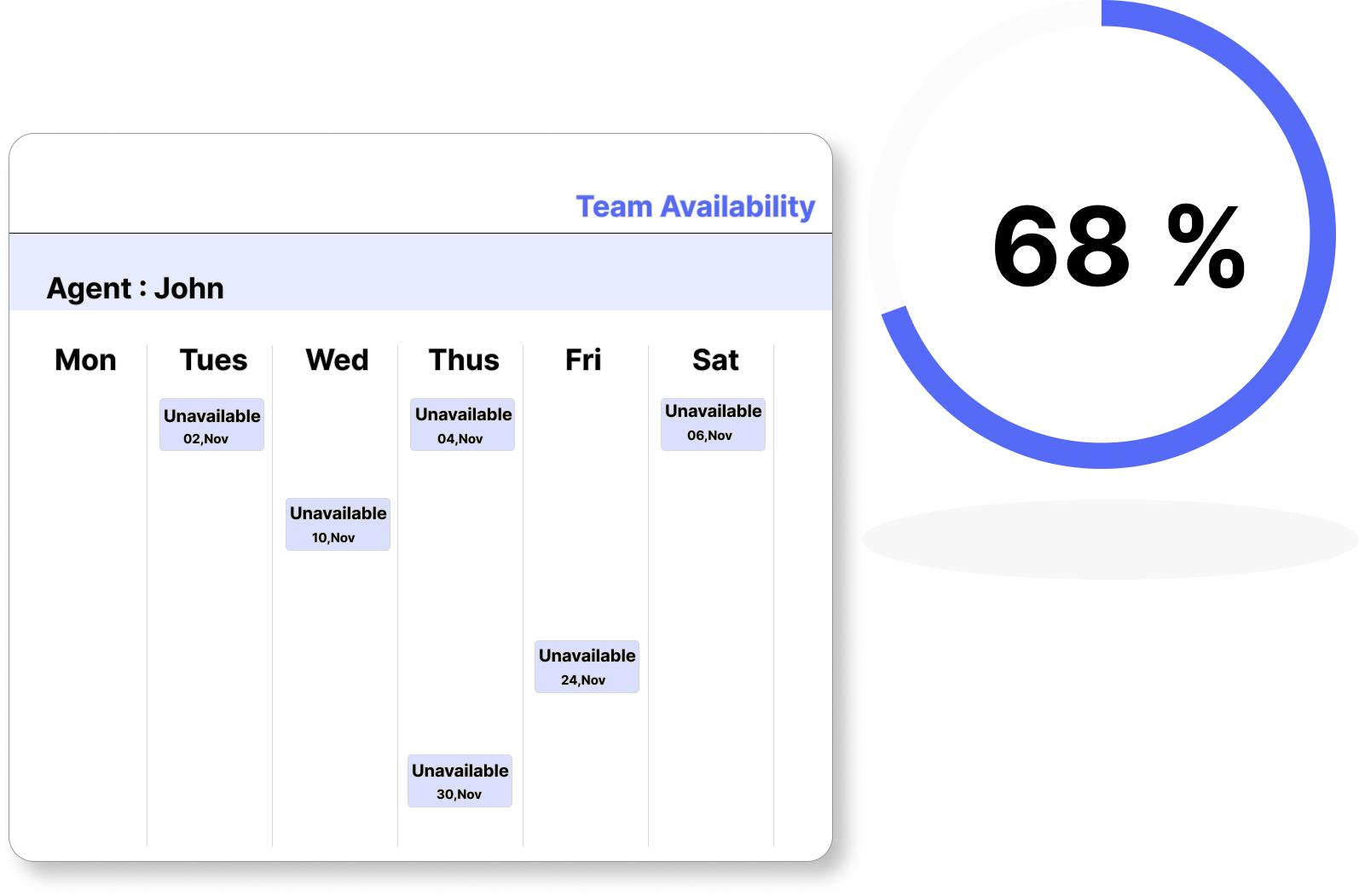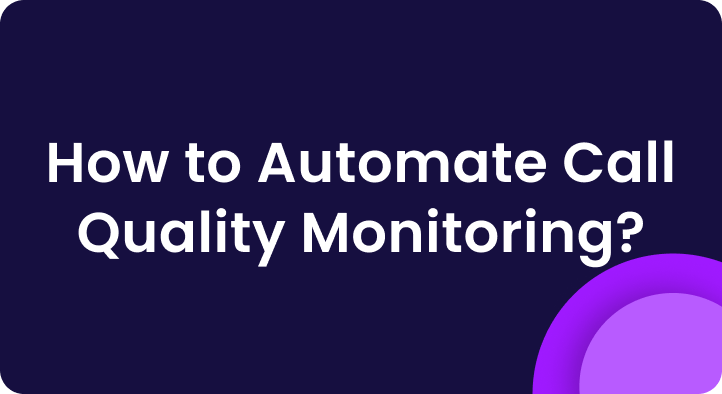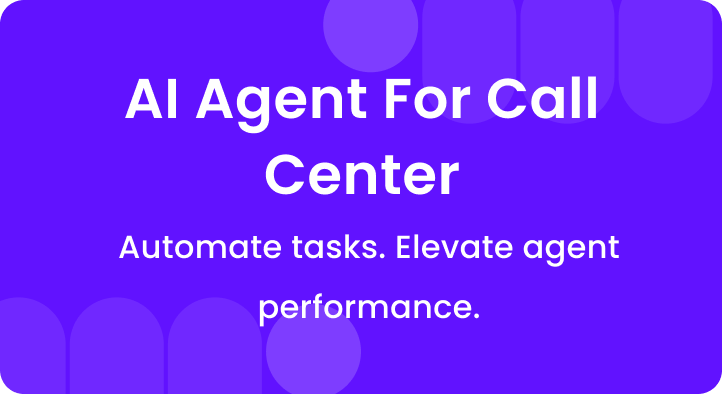Are No Call No Show (NCNS) incidents haunting your call center?
You’re not alone.
Absenteeism costs the industry billions annually, with NCNS being a significant factor in this loss.
Unplanned absenteeism costs over $600 billion annually, averaging $4,080 per full-time employee and $2,040 per part-time worker.
Imagine trying to keep up with customer demand, only to be short-staffed because employees aren’t showing up—without a word.
It’s frustrating, it disrupts your workflow, and it impacts team morale.
But what if there was a way to dramatically reduce these costly absences?
In this post, we’ll dive into the root causes of NCNS, how it impacts your bottom line, and proven strategies that can help you minimize these incidents, improve attendance, and keep your call center running smoothly.
A. What is NCNS No Call No Show in a call center?
In a call center, an NCNS incident occurs when an employee is scheduled to work but does not show up for their shift without informing their employer.
This type of absenteeism disrupts the call center’s workflow, leads to understaffed shifts, and can significantly strain other employees who must cover additional responsibilities.
NCNS can lead to confusion, scheduling chaos, and, ultimately, a decrease in service quality.
Call centers often rely on maintaining strict staffing levels to meet customer demands.
Therefore, an NCNS event can hinder a company’s ability to deliver consistent and high-quality service.

B. What is the impact of NCNS in call centers?
NCNS incidents can have far-reaching consequences in call centers, affecting both the workforce and overall operations. Here are some of the key impacts:

1. Decreased productivity
When an employee fails to show up for their shift without notice, it leaves the team understaffed.
This causes delays, a backlog of calls, and an increased workload for the remaining agents.
As a result, the call center’s overall productivity declines, leading to missed performance targets and lower service levels.
Wonder how to improve productivity? Use the best AI sales tools to boost your call center productivity.
2. Operational disruption
NCNS incidents disrupt the smooth flow of operations within a call center.
Essential processes may be delayed, and team coordination can suffer, affecting key performance indicators such as call resolution time and customer satisfaction.
These disruptions can have a long-term impact on the efficiency and reputation of the call center.
3. Increased employee burnout
Other employees may be forced to work longer hours or take on additional responsibilities to cover missed shifts, leading to physical and mental exhaustion.
This can significantly decrease job satisfaction, as employees may feel overwhelmed and underappreciated, ultimately impacting their engagement levels.
4. Customer service challenges
An understaffed call center is less equipped to handle customer inquiries promptly.
This often results in longer wait times, frustrated customers, and missed opportunities for positive interactions.
Did you know that 78% of customers have backed out of a purchase due to a poor customer experience?
Over time, poor customer experiences can harm the company’s reputation, eroding trust and customer loyalty.
5. Higher costs
Call centers frequently rely on overtime pay or temporary staffing to fill gaps caused by NCNS incidents.
These additional costs can strain the budget and reduce profit margins.
Relying on temporary or last-minute staffing also brings challenges related to the quality of service and staff training.
6. Reduced morale
Frequent NCNS incidents create a toxic work environment where the remaining employees feel they are constantly covering for their colleagues.
This can lead to demotivation, frustration, and decreased team cohesion.
In turn, this may increase employee turnover and affect the call center’s ability to maintain a stable workforce.
7. Increased churn
When employees frequently miss shifts without notice, it places extra pressure on the remaining staff, leading to frustration and burnout.
Over time, this creates a negative work environment where employees feel undervalued and overworked, prompting them to seek opportunities elsewhere.
This cycle of constant turnover can disrupt operations and further hinder the call center’s ability to provide consistent service.
C. Common causes of no call no show
Understanding the root causes of NCNS incidents is crucial for minimizing their occurrence and maintaining a smooth workflow. Here are some of the most common factors:
1. Poor employee engagement
- Lack of emotional connection: Disengaged employees are less likely to prioritize work over personal matters.
- Lack of recognition: Employees who feel unappreciated may be more likely to skip shifts without notice.
- Low morale: Unmotivated employees tend to disengage and fail to show up for their shifts.
2. Inadequate communication
- Outdated scheduling systems: Inefficient or manual scheduling can lead to missed shifts due to forgetfulness.
- Miscommunication: Unclear or inconsistent shift expectations can cause employees to miss shifts without notice.
- Failure to notify employees: Not informing employees of schedule changes may result in them not showing up.
3. Personal or health Issues
- Emergencies: Personal or family emergencies may prevent employees from attending work without prior notice.
- Health concerns: Employees experiencing health issues may not inform their supervisors in advance.
- Unforeseen personal crises: Employees facing sudden challenges may fail to show up without notifying the company.
4. Lack of accountability
- Absence of consequences: No clear consequences for NCNS incidents may lead to employees skipping shifts.
- Inconsistent policy enforcement: Lack of accountability may lead to repeated NCNS without any discipline.
- No disciplinary action: Failure to address repeated NCNS can result in employees disregarding attendance norms.
5. Job dissatisfaction and burnout
- Overwhelmed employees: Burned-out employees may skip shifts due to feeling overworked and stressed.
- Lack of growth opportunities: Employees may disengage and skip shifts if they feel there’s no room for career progression.
- Monotonous work: Lack of variety and challenge in the job can lead to employee absenteeism.
6. Lack of clear policies
- Unclear NCNS policy: A well-defined policy outlining attendance expectations and procedures must be included.
- No termination policy: Lack of clear consequences for repeated NCNS incidents creates confusion and inconsistency.
- Employee awareness: Employees must know what constitutes a no-call or no-show and its repercussions.
D. Expert-recommended strategies to minimize NCNS in call centers
To tackle the challenges of NCNS incidents, we’ve curated a list of strategies after speaking with hundreds of call center owners.
During these conversations, we gained valuable insights into their most common struggles related to NCNS.
Call center leaders shared the difficulties they face in managing attendance and employee workplace accountability, and we’ve compiled these challenges and their corresponding strategies below.
As Tushar Jain, Founder of Enthu.AI, puts it, “Understanding the root causes of NCNS incidents is crucial for effective intervention. At Enthu.AI, we focus on empowering call centers with actionable insights to optimize workforce management.”Learn about Call Center Management: Definition, Challenges, And Strategies. Read the full article here.
1. Improve scheduling flexibility

Flexible scheduling can help employees balance work and personal life better, reducing the likelihood of NCNS incidents.
Call centers can offer shift-swapping options or provide more predictable hours, allowing employees to manage their time more effectively.
By implementing flexible work hours or offering part-time schedules, companies can accommodate employees’ needs, making it less likely for them to skip shifts without notice.
Additionally, offering shift incentives or bonuses for employees who maintain perfect attendance can further motivate staff to attend their shifts regularly.
2. Improve workplace satisfaction
Improving workplace satisfaction is key to reducing NCNS incidents. Here’s how to make it happen:
- Competitive salaries and benefits: Offering attractive wages and comprehensive benefits like health insurance and paid time off shows employees they are valued, increasing loyalty and fewer absentee issues.
- Positive work environment: Cultivating an inclusive and supportive workplace fosters team spirit and boosts morale. Recognize your team’s contributions and encourage camaraderie through team-building activities.
- Regular feedback and recognition: Keep employees engaged by providing ongoing feedback and celebrating their achievements. Feeling appreciated keeps motivation high and absenteeism low.
By focusing on these areas, your call center can see a noticeable improvement in attendance and overall employee satisfaction.
3. Enhance communication

Clear communication is key to preventing NCNS incidents. Call centers should ensure that schedules are easily accessible and provide ample reminders to employees about their upcoming shifts.
This can be done through:
- Email or SMS reminders before shifts
- A centralized online portal where employees can access their schedules and request time off
- Regular communication with team leads or supervisors to confirm attendance
By reinforcing shift expectations through multiple communication channels, call centers can minimize the chances of miscommunication or forgotten shifts.
4. Foster employee engagement
Employee engagement is critical to reducing NCNS incidents. Engaged employees are more likely to take ownership of their responsibilities and improve employee reliability including showing up to work on time and being proactive about communication if they need to miss a shift.
To improve engagement, call centers can:
- Recognize and reward good attendance
- Foster a positive company culture where employees feel valued
- Provide opportunities for career growth and development, making employees feel more invested in their work
Engaged employees are less likely to skip without informing shift management, as they feel a stronger sense of responsibility toward their role and team.
5. Provide training and support

Training is essential in helping employees understand the importance of attendance and its impact on the call center’s overall performance especially in relation to PCI compliance.
This includes:
- Offering new hires a thorough onboarding process where attendance expectations are communicated.
- Providing ongoing support to address any personal or work-related challenges that might lead to missed shifts.
- Using quality assurance measures, such as coaching or feedback, to ensure that employees understand the value of their role in the team.
Call centers can reduce absenteeism and improve attendance rates by providing employees with the tools and support they need to succeed.
6. Set clear policies
Clear, consistent attendance policies are crucial for minimizing NCNS incidents. Call centers should establish and communicate their policies clearly to all employees, including:
- What constitutes an acceptable absence
- How far in advance employees should notify management if they need to miss a shift
- The consequences for failing to notify management or for repeated NCNS incidents
By setting clear expectations and holding employees accountable, call centers can reduce the frequency of NCNS incidents and improve overall attendance.
7. Leverage technology
Leveraging technology can streamline attendance tracking and make it easier to monitor employee behavior. Some tools that call centers can use to reduce NCNS incidents include:
- Attendance tracking software: This helps managers easily track employee attendance, identify patterns, and take proactive measures to address potential attendance issues.
- Conversation intelligence tools: By analyzing calls and interactions, call centers can gauge employee performance and spot call center attendance issues that might indicate disengagement or other underlying problems.
- Speech analytics and quality assurance tools: These technologies can provide valuable insights into employee performance and identify areas where additional training or support may be needed.
Conclusion
Dealing with No Call No Show (NCNS) incidents is an inevitable challenge for your call center, but with the right strategies, you can minimize their occurrence and impact.
You can significantly reduce absenteeism by fostering open communication, practicing strong leadership, and implementing a clear NCNS absenteeism policy.
And when NCNS does happen, having clear guidelines and cultivating a positive work culture will help maintain productivity and morale.
With Enthu.AI’s tools, like speech analytics, agent training, quality assurance, call monitoring, and performance tracking, you can track absenteeism, build stronger relationships between agents and supervisors, and keep your team on track.
Ready to improve?
FAQs
1. How to reduce no call no shows?
To reduce NCNS, improve scheduling flexibility, enhance communication, foster employee engagement, and enforce clear attendance policies. Recognizing and rewarding good attendance can also motivate employees to show up as scheduled.
2. What is NCNS in call center?
NCNS (No Call No Show) refers to an employee failing to attend their scheduled shift without informing their supervisor in advance. It disrupts operations and can affect team productivity and morale.
3. How do you save yourself from a no call no show?
To avoid NCNS, maintain open communication with your supervisor about attendance issues. Set reminders for your shifts, and if you can’t make it, notify in advance to ensure your absence is covered correctly.



 On this page
On this page

